
The R-15 from Remington was found to be well mannered, accurate and a rifle particularly suited for hunting deer, antelope and similar size game. The idea of creating a .223 Remington length cartridge in .308 caliber with about twice the powder capacity was a good one, as it allows the hunter the option of carrying this type of firearm into the woods without having to step up to a very large and heavy AR-10 type. Yes, I am aware and own, or have owned, .458 and .50 caliber guns in this cartridge length, but none could really handle the naturally heavy weight bullets for the respective bore sizes. Consequently, rounds like the .50 Beowulf are generally limited to short shank pistol bullets and bullets of more fragile construction.
The 30 Remington AR in context…
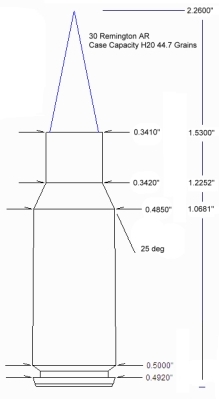
|
Cartridge |
M | 100 yds | 200 yds | 300 yds | |
| 223 Remington | FPS | 3240 | 2854 | 2500 | 2172 |
| Ft/Lbs | 1283 | 995 | 763 | 576 | |
| Traj “ | – | 1.5 | 0 | -7.1 | |
| 30 Remington AR | FPS | 2800 | 2531 | 2278 | 2039 |
|---|---|---|---|---|---|
| Ft/Lbs | 2176 | 1778 | 1440 | 1153 | |
| Traj “ | – | 2.0 | 0 | -8.7 | |
| 308 Winchester | FPS | 2700 | 2501 | 2311 | 2129 |
| Ft/Lbs | 2670 | 2292 | 1957 | 1661 | |
| Traj “ | – | 2.0 | 0 | -8.6 | |
The R-15 Remington chambered for this cartridge turned out to be a superstar when it came to accuracy and consistency. Shooting group sizes so small that, just a few years ago, would have been seen as the province of an expensive bolt action target rifle. At the time of this writing… no, not that writing, this writing, Remington offered three loads in the 123 – 125 grain range and one at 150 grains. These are excellent basic loads, however, with so many good .308″ caliber bullets with high sectional density and ballistic coefficient values a little handload development seemed appropriate, particularly the possibility of bumping up weight a bit.
A starting point…
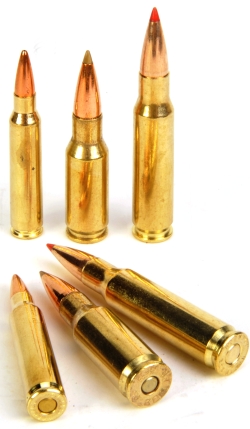
The 30 Remington AR, flanked by the .223 Remington and .308 Winchester, is a bit like a sawed off .284 Winchester… only with a 0.020″ larger diameter rim. With a case body diameter of 0.500″, it is larger than the .308 Winchester, but vertically challenged. Where the .284 Winchester holds 68 grains of H20, the 30 Remington AR holds 45 grains. The 30 Remington AR probably won’t drive 220 grain bullets to ignition by friction, but the round is certainly a major leg up on the .223 Remington.
The SAAMI pressure of 55,000 PSI is the same as .223 Remington and as the pressure curve determines safe and reliable operation of the firearm, it is probably best left at this level. The 30 Remington AR pressure is substantially higher, approximately 50% higher, than other specialty cartridges of similar case web diameter like the 450 Bushmaster and .50 Beowulf with bolt thrust in the area of 7,000 lbs which is not much more than the .223 Remington exerts.
Remington loads all use small rifle magnum primers with a very short granular extruded powder. Could be the powder type or the case geometry. I used the same type of primers in all of the loads that appear for this cartridge.
Maslow’s Hierarchy and the 30 Remington AR…

|
The 125 grain was a natural, so I began there to establish a baseline for the balance of the handloads. I ran a little redundancy on a couple of Barnes MRX weights as the Silvex core bullets are heavier than monolith copper, but lighter than lead and I wanted to test the effect of the additional lower density bullet length. The Berger bullet was selected because I saw some velocity potential when working within spec pressure as the BC is so favorable to retained velocity and energy at longer distances… In my world that is anything greater than 300 yards.
A couple of notes on die sets and assembly…
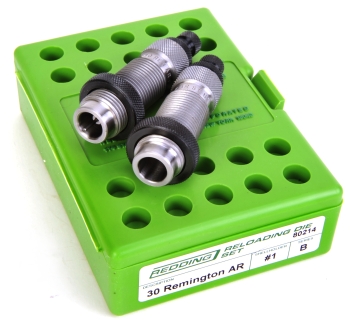
Locating a full length sizer set of dies took a little doing. A Redding die set was located at Sinclair International. Dies on other sites were either on backordered or they had not yet been listed. I’m not sure why the short supply as the SAAMI drawings were released on 6/17/09.
Redding has since changed the shell holder reference that appears on this box. #1 is for the .308 Winchester and similar 0.4730″ rim ammo. The 30 Remington AR has a 0.4920″ rim, which is too large for the #1. I used a #2 .30-30 WCF shell holder and trimmer shell plate, however, I believe Redding is formally going to their #33 as the cross referenced shell holder notation that will appear on boxes.
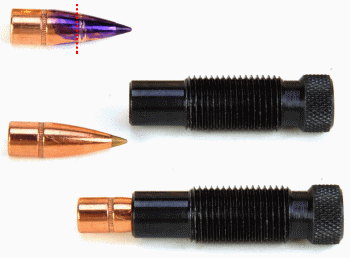
Most of the bullets for this cartridge have a very shallow ogive. The face of the seat plug was cut wide which allowed bullets to go as far as half an inch into the plug. The result was that the plug ran out of adjustment range, in most cases, before proper cartridge overall length or bullet seating could be attained. I made a prototype plug from a bolt. It has a quarter inch more thread projecting upward, the same outside diameter nose, but with the plug’s minimum diameter bore reduced from 0.270″ to 0.220″ and radiused. The nose was shortened to 0.300″ to prevent it from prematurely running into the shoulder within the die body.
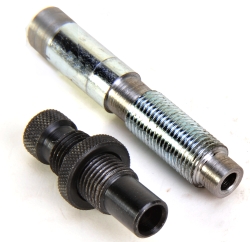 The reduction in bore moved the plug just about a quarter of an inch back up toward the tip of the bullet and the added plug thread length on top permitted use of the plug’s lock ring, something I couldn’t do with the standard plug.
The reduction in bore moved the plug just about a quarter of an inch back up toward the tip of the bullet and the added plug thread length on top permitted use of the plug’s lock ring, something I couldn’t do with the standard plug.
I’m not suggesting, as a steady diet, that it’s good to make seater plugs. However, in a pinch, a bolt with the right thread and access to a small lathe can save a lot of waiting time so theories can be quickly proven out or dismissed in advance of a major investment in time and effort. I’m not a good machinist, however, I am beyond the stage where everyone is ducking to avoid flying parts. Beside, fabricated parts don’t have to be MilSpec, they just need to work… and this one did…
Comparing handloads…
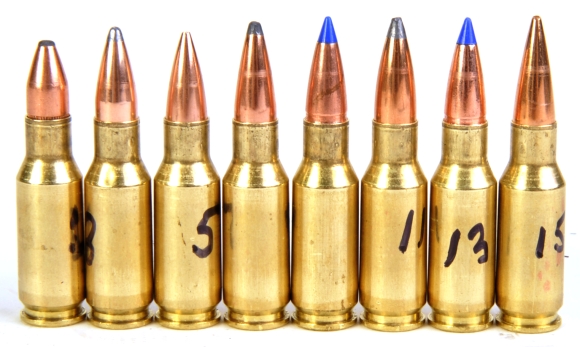
The only assembled cartridge that couldn’t meet the 2.260″ cartridge overall length spec was the 175 grain Berger VLD, at least without placing the bullet’s ogive below the case mouth. The magazine and action clearance checked to a potential 2.285″, however, I set the maximum at 2.275″ which seemed to work without a hitch. Other than the plug issue, the dies worked as intended, the rounds were easy to assemble and I had to stop myself from including too many component variations as there are so many available.
| Bullet Type | Bullet Weight |
# | Bullet Diameter |
C.O.L. | Powder Type |
Charge | Primer Type |
Muzzle Velocity |
Muzzle Energy |
| Remington PSP | 125 | – | .308 | 2.070 | Benchmark | 38.0 | CCI 450 | 2859 | 2269 |
| Remington PSP | 125 | – | .308 | 2.070 | IMR 4198 | 33.5 | CCI450 | 2847 | 2219 |
| Hornady GR SP | 130 | 3020 | .308 | 2.170 | Benchmark | 37.2 | CCI 450 | 2778 | 2228 |
| Sierra MK | 135 | 2123 | .308 | 2.140 | Re10x | 33.5 | CCI 450 | 2580 | 1996 |
| Sierra MK | 135 | 2123 | .308 | 2.140 | IMR 4198 | 31.0 | CCI450 | 2602 | 2030 |
| Hornady | 150 | 3033 | .308 | 2.220 | Re10x | 33.5 | CCI450 | 2522 | 2119 |
| Barnes MRX | 150 | 30882 | .308 | 2.260 | Re10x | 32.0 | CCI450 | 2440 | 1983 |
| Sierra SPBT | 165 | 2145 | .308 | 2.260 | Re10x | 31.5 | CCI450 | 2293 | 1927 |
| Sierra SPBT | 165 | 2145 | .308 | 2.260 | RS TAC | 36.0 | CCI450 | 2304 | 1945 |
| Barnes MRX | 165 | 30885 | .308 | 2.260 | Re10x | 30.5 | CCI450 | 2237 | 1834 |
| Barnes MRX | 165 | 30885 | .308 | 2.260 | RS TAC | 36.0 | CCI450 | 2216 | 1800 |
| Berger VLD 30512 | 175 | 30512 | .308 | 2.275 | Re10x | 30.0 | CCI450 | 2165 | 1822 |
| Berger VLD 30512 | 175 | 30512 | .308 | 2.275 | RS TAC | 34.0 | CCI450 | 2177 | 1842 |
| Bullet Type | Bullet Weight |
Muzzle | 100 | 200 | 300 | |
| Remington PSP | 125 | Velocity | 2859 | 2526 | 2218 | 1934 |
| Energy | 2268 | 1771 | 1366 | 1038 | ||
| Path | -1.5 | 2.0 | 0 | -9.1 | ||
| Hornady GR SP | 130 | Velocity | 2778 | 2480 | 2202 | 1943 |
| Energy | 2227 | 1775 | 1399 | 1090 | ||
| Path | -1.5 | 2.1 | 0 | -9.3 | ||
| Sierra MK | 135 | Velocity | 2602 | 2380 | 2169 | 1971 |
| Energy | 2029 | 1697 | 1411 | 1164 | ||
| Path | -1.5 | 2.3 | 0 | -9.7 | ||
| Hornady | 150 | Velocity | 2522 | 2276 | 2044 | 1828 |
| Energy | 2118 | 1725 | 1392 | 1113 | ||
| Path | -1.5 | 2.6 | 0 | -11.0 | ||
| Barnes MRX | 150 | Velocity | 2440 | 2241 | 2052 | 1874 |
| Energy | 1983 | 1673 | 1403 | 1169 | ||
| Path | -1.5 | 2.7 | 0 | -11.0 | ||
| Sierra SPBT | 165 | Velocity | 2304 | 2105 | 1916 | 1738 |
| Energy | 1945 | 1623 | 1345 | 1107 | ||
| Path | -1.5 | 3.2 | 0 | -12.7 | ||
| Barnes MRX | 165 | Velocity | 2237 | 2056 | 1885 | 1722 |
| Energy | 1833 | 1549 | 1302 | 1087 | ||
| Path | -1.5 | 3.4 | 0 | -13.2 | ||
| Berger VLD 30512 | 175 | Velocity | 2165 | 2019 | 1880 | 1746 |
| Energy | 1821 | 1584 | 1373 | 1185 | ||
| Path | -1.5 | 3.5 | 0 | -13.5 |
OK, enough time spent looking for reasons to keep shooting…

Handloading for the 30 Remington AR and the R-15 was stress free, particularly in light of the relative age of the combination. The gun shoots sub MOA all day long and with pretty much whatever ammo it is fed. For cartridge size I believe the 22″ barrel is about optimal and Remington was nice enough to button up the R-15 package to include a pretty nifty hard case.
The 125 to 175 grain bullet range is useful and the 30 Remington AR handles them all well. I personally liked the 175 grain because it offered the highest retained kinetic energy and drop at 300 yards was not significantly greater than even the little 125 grain loads. Sub 150 grain bullets are more than sufficient for deer and similar size game hunting so bullet selection really gets to be personal preference and perhaps penetration with heavier weight bullets. Very nice gun, excellent cartridge introduction – both something to plan on in future use.
Remington’s R-15 Xtreme Hunting Rifle Part I
Remington’s R-15 Xtreme Hunting Rifle Part II

Email Notification